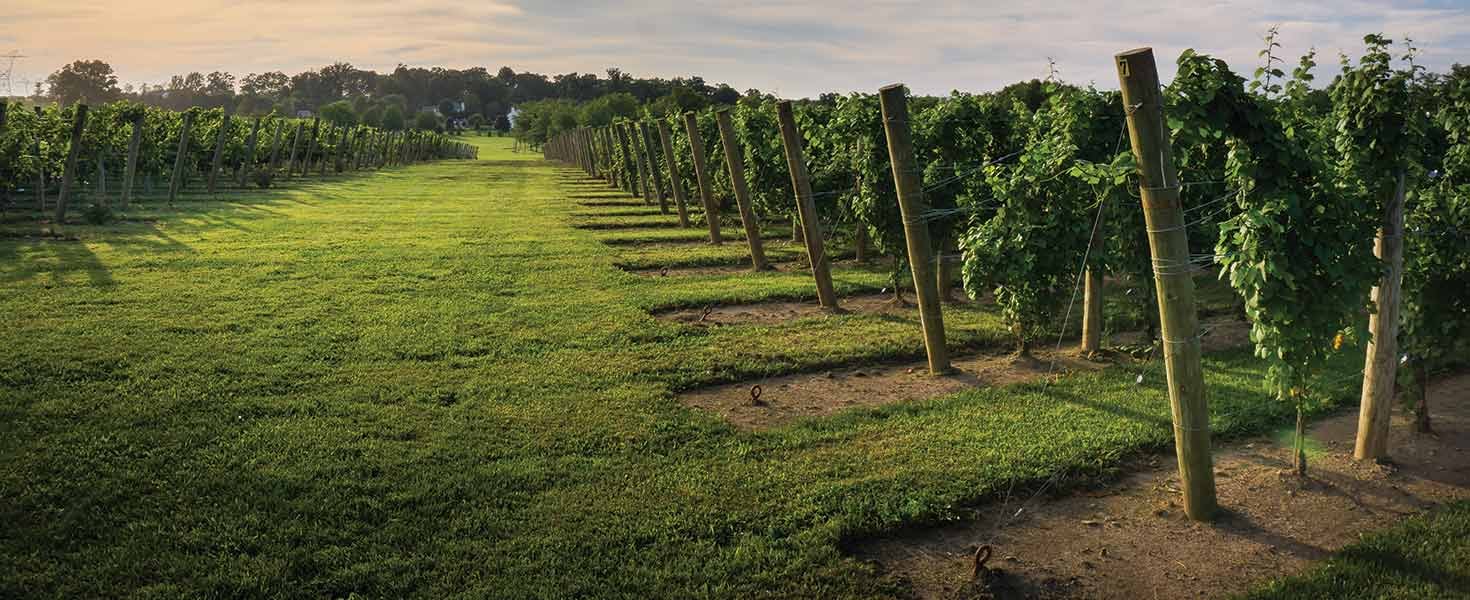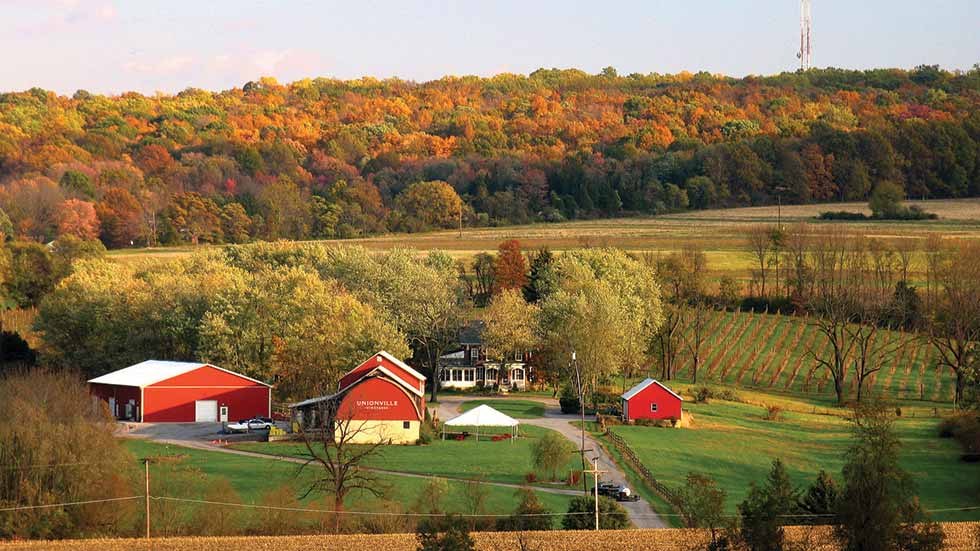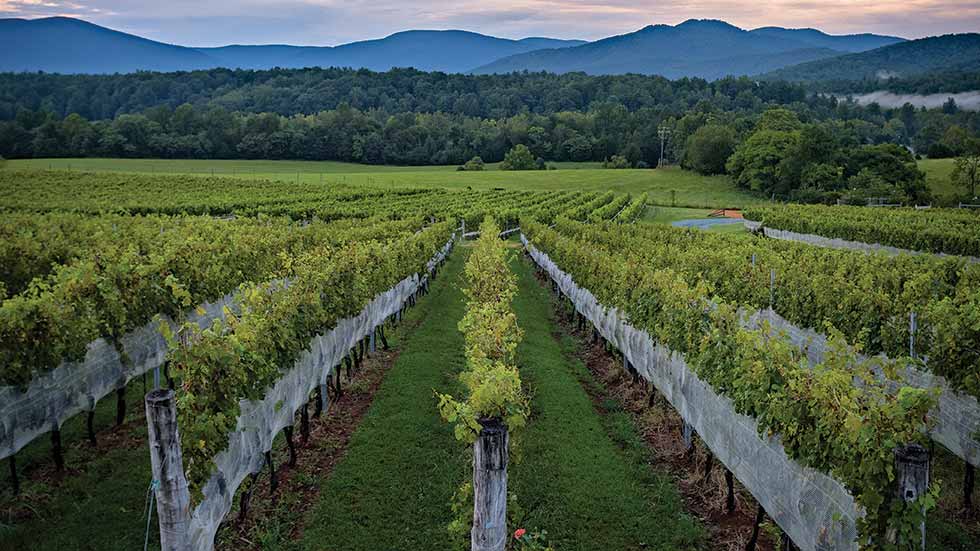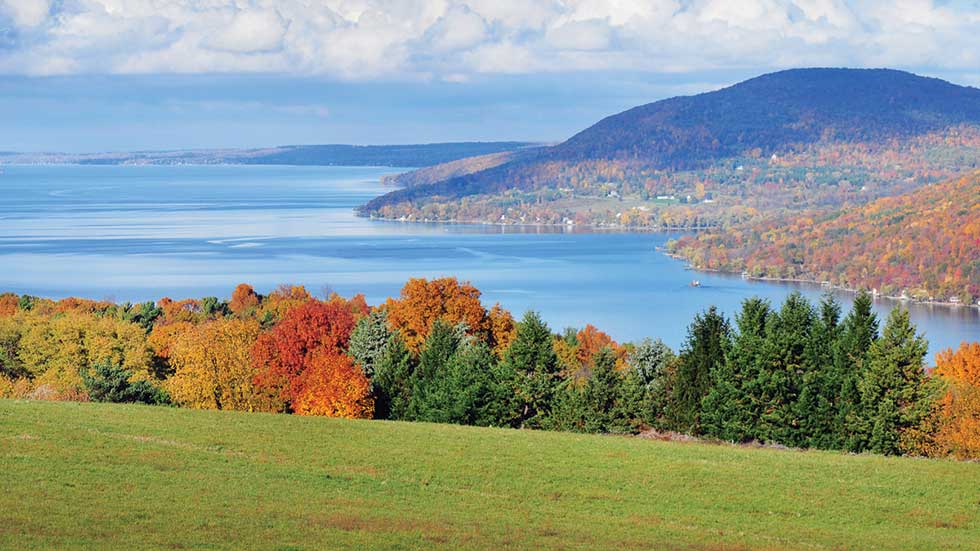Take A Wine Country Road Trip
Nearby destinations offer wold-class wine regions with amazing scenery, warm hospitality, and superb wine

Pictured above: Beneduce Vineyards grows a variety of red and
white grapes on 20 acres of a sun-drenched
hillside in Franklin Township, New Jersey.
Courtesy of Beneduce Vineyards
As the wine industry saying goes, grapes don’t grow in unattractive places. Road tripping into East Coast wine country guarantees fetching scenery and compelling stories revealed by the landscape. Vineyards, shaped by geology and humans, imprint this synergy in a bottle of wine. Good restaurants are never far, many drawing on local ingredients to pair with the latest vintage from up the road. Country inns and historic bed-and-breakfasts offer a restorative break in attractive boutique settings. Whether you want to get away for a few days or a week, here are three wine regions perfect for low-effort, high-reward exploration.
HUNTERDON COUNTY, NEW JERSEY
Debunk the myth of New Jersey as the turnpike state with
a long weekend in Hunterdon County. This slice of Jersey
ag country is where “highway yields to hay bale and horse
pasture,” says John Cifelli, general manager of Unionville
Vineyards in Ringoes. Anchored north and south by the
quaint towns of Lambertville and Clinton, Hunterdon
County’s rural areas in between are filled with vineyards,
farms, nature parks and historic landmarks.
On a charming site hugging the Delaware River, vibrant Lambertville offers two towns in one with its bridge to sister city New Hope, Pennsylvania. Hunt for vintage décor in Lambertville’s antique shops, or grab a cappuccino from third-wave coffee joint Rojo’s Roastery for a canal-side stroll. Fox & Hound Bed & Breakfast, a family farm in Bucks County, Pennsylvania, offers intimate lodging with historical ties to George Washington. B&B guests can explore a crumbling stone barn that housed Continental Army soldiers in the winter of 1776—the same men who would later cross the Delaware River that fateful Christmas Eve.
Hunterdon County has yet to be earmarked for an appellation or American Viticultural Area (AVA), so for now, it’s a checkerboard of first- and second-generation grape growers and winemakers tweaking their strategies to match variety to site, a process which takes years. Though New Jersey doesn’t have a star grape—think cabernet to Napa—experts praise the chardonnays, pinot noirs and rieslings.
Mike Beneduce, owner and winemaker at Beneduce Vineyards in Pittstown, has his own hunches. “Northern European varieties like riesling, gewürztraminer, pinot noir and blaufränkisch have the most promise,” he says, noting commonalities in soil and climate.
“Those countries have had centuries of trial and error to figure out what grapes work … so it makes sense to use that knowledge to our advantage,” he says. Beneduce’s blaufränkisch, an Austrian red grape, has been called a benchmark wine for New Jersey. Beeline for the winery’s vineyard-framed patio to taste and draw your own conclusions.
About 15 miles south of Beneduce sits Unionville Vineyards. As you make your way there, detour briefly through sleepy Flemington for a glance at Main Street in the historic district. Though currently closed due to redevelopment litigation, the Union Hotel, built in 1814, attracted affluent stagecoach passengers with its flair for hospitality. Recharge with a coffee or local kombucha at Factory Fuel Co.

A tented patio next to the big red barn at Unionville Vineyards in Ringoes, New Jersey, offers a scenic setting for wine tasting.
Courtesy of Unionville Vineyards
Accolades for Unionville’s fresh European-style wines continue to accumulate. White-wine drinkers should share a bottle of riesling or chardonnay in the shade of Unionville Vineyard’s big red barn. For those who prefer red wine, the anise and spice hints in the winery’s cabernet franc suit the Di Bruno Bros. salumi and cheese board offered on weekends.
Situated in the county’s northern stretch, Alba Vineyard & Winery, just outside the county’s northwest border, and Mount Salem Vineyards could occupy a full day. Colorful flowers frame Alba’s pergola-covered courtyard. Breezes off the vineyard refresh guests as they sip raspberry-hued pinot noir.
Like Beneduce, Mount Salem Vineyards takes a hard look—with good results—at Austrian grapes. Try the dark and plummy blaufränkisch or the zweigelt, which brims with cherries. Pick up a few bottles to enjoy at home, pairing them with local produce. Farm stands found on back roads sell New Jersey’s famous beefsteak tomatoes and silver queen corn.
Clinton, near the top of Hunterdon County, offers a classic American Main Street experience. Its four-story Red Mill, one of the most photographed locations in New Jersey, functioned as a mill for nearly 100 years, first for wool, then grain, graphite and finally talc. History buffs can pop into the museum, housed inside the old mill, and explore the buildings that compose Red Mill Museum Village. Then head to the patio of The Clean Plate Kitchen for healthy farm-to-table fare and prime views of the Raritan River.
CHARLOTTESVILLE, VIRGINIA
The spirit of America’s founding days prevails around
Charlottesville, a city built before the Revolutionary War. The
city lies two hours south of Washington, DC. Route 29, the
main artery into the city from both north
and south, parallels sections of a former
stagecoach road and cuts through a rural
landscape that enticed Thomas Jefferson to
build a home, university and vineyards here.
After his presidency, Jefferson retired to the estate he called Monticello. Known for his careful observations of the natural world, he experimented with viticulture and winemaking. “I have often thought that if heaven had given me choice of my position & calling, it should have been on a rich spot of earth, well watered, and near a good market for the productions of the garden. No occupation is so delightful to me as the culture of the earth,” he wrote to Charles Willson Peale in 1811.
Though Jefferson failed to produce a bottle of wine, modern winemakers who’ve cracked the code understand the appeal of trying.
Countryside charms abound in the Charlottesville region. Expansive horse farms abut stately Federal-style homes. Historic inns and taverns serve travelers in the same booths where early legislators argued over politics while enjoying whiskey and beer. Vineyards blanket the gaps in between.

The Blue Ridge Mountains provide
a stunning backdrop to the
vineyards at Stinson Vineyards in
Crozet, Virginia.
Photo By Darron Franta
“The 350-acre property surrounding our tasting room in Madison offers the soft rolling hills that make wine country so picturesque,” says Aileen Sevier, director of marketing at Early Mountain Vineyards.
The Monticello AVA was established in 1984, and among its wineries are some of Virginia’s earliest and best. Barboursville Vineyards in Barboursville, a regional pioneer, was founded in 1976. That’s the same year as the Judgment of Paris, a wine competition that marked a turning point in America’s vinous reputation when California wines beat French submissions in a blind tasting. Nevertheless, the region remains in a state of genesis. With few rules to follow, winemakers have free rein to experiment. More than four decades of trials have revealed promising wines: cabernet franc, petit verdot and red blends as well as white grapes viognier and petit manseng.
George Hodson, president of the Monticello Wine Trail, an association of more than 30 area wineries, and CEO of Veritas Vineyard & Winery in Afton, is excited about the future of the Central Virginia wine region. “We have a core of young winemakers who are committed to making this region a part of the national and international conversation on wine,” he says. Such conversations can be pursued at a variety of outdoor tasting spaces.
Fifteen minutes outside Charlottesville’s city limits, King Family Vineyards feels miles away in scenery with the foothills of the Blue Ridge Mountains as its backdrop. Plan a languorous day on the patio, especially if a polo match is underway. Owners David and Ellen King host matches at adjacent horse farm Roseland. King Family Vineyards’ “classic” tasting of five wines proves popular, as does simply cracking open a bottle of its meritage, a merlot-based bordeaux-style blend.
Family-owned Stinson Vineyards in Crozet capitalizes on its postcard-pretty setting. Tidy rows of vineyards stretch from the property’s edge toward the Blue Ridge Mountains. Guests savor flights of French-inspired wines while browsing farm store goods. Many of Virginia’s wineries have lodgings, a boon for travelers hoping to drink up the region by the glass. The sunrise glows above vineyard accommodations for guests at Barboursville, Veritas, Stinson and Afton Mountain. For a night in the city, try Charlottesville’s boutique Quirk Hotel by Hyatt or The Draftsman, a Marriott Autograph Collection property.
FINGER LAKES, NEW YORK
Water is the reason wine grows in Upstate New York, about
four hours north and west of Manhattan. The waters of the
11 Finger Lakes, including the deepest—Canandaigua,
Keuka, Seneca and Cayuga—moderate wintertime vineyard
temperatures from summer heat stored in their depths.
Viewed from above, the lakes, which run north–
south, evoke
a celestial handprint or swipe of Ursa Major’s paw. Retreating
glaciers carved the ancient trenches of this budding wine region.
Though the Finger Lakes region lacks the international reputation of California, stellar wine is being made from riesling and cabernet franc grapes. The promise of quiet and the low population bundled with a more affordable cost of living and good quality of life have attracted highly credentialed professionals to its soil. Larger cities within driving distance and regional airports bring a measured influx of tourists—never too crowded, just right.
Master of Wine Nova Cadamatre makes riesling and chablisstyle chardonnay from grapes grown in her vineyard on Seneca Lake for her brand Trestle Thirty One. She lights up when describing the Finger Lakes region. “The scenery is magnificent. I’ve been to many places in t he world, and I still feel that it is the most beautiful,” she says. “One of the best parts of visiting the area is enjoying the scenic drives and spontaneous vistas.”
Nancy Irelan, co-owner and winemaker for Red Tail Ridge Winery on the west side of Seneca Lake, left a corporate California winery for the Finger Lakes in 2004. A recent James Beard Award nomination validated that decision. She works with Austrian and Northern Italian grapes such as blaufränkisch, teroldego and lagrein. Red Tail Ridge also produces sparkling wine and cabernet franc, which guests can sample in the tasting room. “Grapes that do well in European regions with similar climates do well here,” she says.

Wineries are arrayed along the shores of Canandaigua Lake in New York’s Finger Lakes region.
Courtesy of Finger Lakes Visitors Connection
Rick Rainey is the managing partner behind Forge Cellars, a brand lauded for the quality and complexity of its dry rieslings. “We can pick riesling very late in the season and end up with rich, textural and aromatic whites,” he says. Forge conducts tastings by appointment in a modern black barn on Seneca Lake.
Beyond the region’s wine, the lakes, waterfalls and hiking in Finger Lakes National Forest, east of Seneca Lake, bring joy to locals and visitors alike. To get to work, Rainey rides his motorcycle on the gravel roads through the woods. “It is heavenly, and each day, I am grateful,” he adds. Each lake has an organized wine trail, though to cherry-pick, try to hit the following (from east to west): Heart & Hands Wine Company on Cayuga’s eastern shore; Sheldrake Point Winery on Cayuga’s western shore; Atwater Estate Vineyards on Seneca’s eastern shore; Hermann J. Wiemer, Anthony Road Wine Country, Billsboro Winery and Ravines Wine Cellars on Seneca’s western shore and Dr. Konstantin Frank Winery on Keuka’s western shore. Driving between tasting rooms quickly turns tedious, however, as the lakes are long and lack bridges. Most itineraries stick to wineries in clusters with lodging nearby.
Around Cayuga Lake, the gorgeous restored homes of The Inns of Aurora are an unmissable stay. The town of Aurora, population 724, hasn’t changed much since its founding in 1789. The Lake House on Canandaigua, overlooking the marina, just debuted its stylish rooms and Rose Tavern Restaurant. The best option in Geneva, at the top of Seneca Lake, is historic hotel Belhurst Castle. For a sleepy place, Geneva boasts an admirable density of creative cooking. On Linden Street, patrons vie for seats at F.L.X. Table, owned by a master sommelier, stopping for cocktails at The Linden Social Club before or after.
From Upstate New York to western New Jersey and down to Central Virginia, historic towns, farms and vineyards thrive. California’s wine country might get more attention, but the East Coast offers wine-focused destinations that are just as scenic and tasty.
